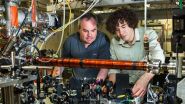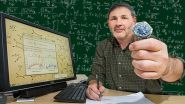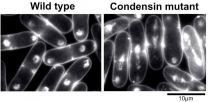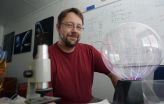INFORMATION:
Also on this study are Susan Mayes, professor of psychiatry; and Sally Lobs and Amanda Black, Penn State College of Medicine Class of 2015, Eugenia Gisin, Penn State College of Medicine Class of 2017, and Megan Veglia, Penn State College of Medicine Class of 2018.
Autism and rare childhood speech disorder often coincide
2015-05-27
(Press-News.org) Some children with autism should undergo ongoing screenings for apraxia, a rare neurological speech disorder, because the two conditions often go hand-in-hand, according to Penn State College of Medicine researchers.
Over the course of a three-year study, 64 percent of children initially diagnosed with autism were found to also have apraxia. The study also showed that the commonly used Checklist for Autism Spectrum Disorder (CASD) accurately diagnoses autism in children with apraxia.
"Children with apraxia have difficulty coordinating the use of their tongue, lips, mouth and jaw to accurately produce speech sounds, so that each time they say the same word, it comes out differently, and even their parents have difficulty understanding them," said Cheryl Tierney, associate professor of pediatrics.
It's estimated that one in 68 children in the United States has autism and one to two in 1,000 have apraxia. With increased recognition and improved evaluation measures, more children are being identified with autism and apraxia. Developmental experts have long noted autism and apraxia seem to frequently coincide.
The researchers studied 30 children between the ages of 15 months and five years who were referred to the Penn State Hershey Pediatric Developmental Communication Assessment Clinic for concerns regarding speech, language or autism. After an initial diagnostic screening, follow-up testing showed that 63.6 percent of children initially diagnosed with autism also had apraxia and 36.8 percent of children initially diagnosed with apraxia also had autism.
The researchers determined that about a quarter of children studied -- 23.3 percent -- had both autism and apraxia at the initial diagnosis, and the same amount had neither condition. Researchers report their results in the Journal of Developmental and Behavioral Pediatrics.
Outcomes for both autism and apraxia can be improved with early intervention, so the findings point to the importance of ongoing apraxia assessment for some children with autism, and vice versa.
Based on the study, Tierney believes that children with autism or apraxia who are non-verbal should be screened for the other condition until they start talking.
The new study also verified that the CASD, a commonly used autism tool, does not over-diagnose autism in children with apraxia.
Penn State College of Medicine psychologist Susan Mayes developed the CASD. It was standardized on children with language disorders -- trouble in using language for expression -- but not for speech disorders -- trouble producing the sound -- so clinicians have wondered if it could accurately be used in children with apraxia.
"We were concerned that children with childhood apraxia of speech were being mislabeled as having autism when they were being evaluated for it, but we found that this was not the case," Tierney said.
To test the accuracy of the CASD in children with apraxia, the researchers used four other tools, which included two assessments for autism and two assessments for apraxia. Overall, the CASD was 97 percent sensitive, and it accurately diagnosed autism in 95 percent of children with apraxia.
"We found that in our diagnostic center, we were not over-diagnosing autism in a cohort of children that had a concern for childhood apraxia of speech," Tierney said.
Autism and apraxia have very different interventions, so making a correct diagnosis is important for preventing long-term problems.
"CASD is used to diagnose autism, but it can also be used to rule out autism," Tierney said. "We wanted to make sure this tool came out negative in a child that just had apraxia and we found that it really does help us distinguish kids accurately. Children who had apraxia without autism, children who had autism but not apraxia, or those who had both or neither were picked up accurately. The tool was very sensitive in picking up all those different combinations. And that's good news because we want the right treatment for the right child for the right diagnosis."
ELSE PRESS RELEASES FROM THIS DATE:
Experiment confirms quantum theory weirdness: ANU media release
2015-05-27
The bizarre nature of reality as laid out by quantum theory has survived another test, with scientists performing a famous experiment and proving that reality does not exist until it is measured.
Physicists at The Australian National University (ANU) have conducted John Wheeler's delayed-choice thought experiment, which involves a moving object that is given the choice to act like a particle or a wave. Wheeler's experiment then asks - at which point does the object decide?
Common sense says the object is either wave-like or particle-like, independent of how we measure ...
Physicists solve quantum tunneling mystery: ANU media release
2015-05-27
An international team of scientists studying ultrafast physics have solved a mystery of quantum mechanics, and found that quantum tunneling is an instantaneous process.
The new theory could lead to faster and smaller electronic components, for which quantum tunneling is a significant factor. It will also lead to a better understanding of diverse areas such as electron microscopy, nuclear fusion and DNA mutations.
"Timescales this short have never been explored before. It's an entirely new world," said one of the international team, Professor Anatoli Kheifets, from The ...
Protein scaffold
2015-05-27
This news release is available in Japanese.
Right before a cell starts to divide to give birth to a daughter cell, its biochemical machinery unwinds the chromosomes and copies the millions of protein sequences comprising the cell's DNA, which is packaged along the length of the each chromosomal strand. These copied sequences also need to be put back together before the two cells are pulled apart. Mistakes can lead to genetic defects or cancerous mutations in future cell generations.
Just like raising a building requires scaffolding be erected first, cells ...
Omitting market risk factor creates critical flaw in case-shiller home price indices
2015-05-27
The method used to calculate Standard & Poor's Case-Shiller Home Price Indices, the most trusted benchmark for U.S. residential real estate prices, contains a flaw that likely could lead to misstating its monthly estimates, according to a newly published study led by faculty at Florida Atlantic University.
The paper published in the Journal of Real Estate Research identifies an important deficiency in the Weighted Repeated Sales (WRS) method developed by economists Karl Case and Robert Shiller, which compares repeat sales of the same homes in an effort to study home ...
Hip fractures in the elderly caused by falls, not osteoporosis
2015-05-27
Anti-osteoporotic medication is not an effective means for preventing hip fractures among the elderly, concludes a study recently published in the BMJ.
Proximal femoral fractures (i.e., hip fractures) occur in the world at a rate of 1.5 million per year, or 7,000 per year in Finland. As most such fractures occur among older people, their number is expected to grow as the population ages. Hip fractures often lead to permanently reduced mobility, quality of life and general health, as well as result in significant social costs.
Since the early 1990s, anti-osteoporotic ...
Challenging students benefit from limit setting
2015-05-27
The teacher's interaction style can either foster or slow down the development of math skills among children with challenging temperaments. This was shown in the results of the study "Parents, teachers and children's learning" carried out at the University of Jyväskylä, Finland.
Ph.D. Jaana Viljaranta, along with her colleagues, studied the role of teachers' interaction styles in academic skill development among children with different temperamental characteristics.
A child's challenging temperament may show up in the classroom, for example, as low task-orientation ...
The analogy that builds human thought
2015-05-27
When Niels Bohr hypothesised his model of atom with the electrons orbiting the nucleus just like satellites orbit a planet, he was engaging in analogical reasoning. Bohr transferred to atoms the concept of "a body orbiting another", that is, he transferred a relation between objects to other, new objects. Analogical reasoning is an extraordinary ability that is unique to the human mind, is not seen in animals (except very rarely in primates) and that forms the basis of highly sophisticated human thoughts. Scientists have wondered about the origin of this cognitive function: ...
Experiments in the realm of the impossible
2015-05-27
Jena (Germany) March 1938: The Italian elementary particle physicist Ettore Majorana boarded a post ship in Naples, heading for Palermo. But he either never arrives there - or he leaves the city straight away - ever since that day there has been no trace of the exceptional scientist and until today his mysterious disappearance remains unresolved. Since then, Majorana, a pupil of the Nobel Prize winner Enrico Fermi, has more or less been forgotten. What the scientific world does remember though is a theory about nuclear forces, which he developed, and a very particular elementary ...
Hodgkin's lymphoma: The treatment can have late sequelae
2015-05-27
Hodgkin's lymphoma--cancer of the lymph nodes--arises in more than 150 children and adolescents in Germany each year. Nine out of ten patients survive the disease, thanks to the highly effective treatments that are now available. Depending on the type of treatment given, however, there may be late sequelae, as discussed by Wolfgang Dörffel and colleagues in an original article in the current issue of Deutsches Ärzteblatt International (Dtsch Arztebl Int 2015; 112: 320-7). These authors studied the question of which types of treatment were more likely to be followed ...
Similarities between aurorae on Mars and Earth
2015-05-27
An international team of researchers has for the first time predicted the occurrence of aurorae visible to the naked eye on a planet other than Earth.
Mars' upper atmosphere may be indeed closer to Earth's than previously thought. Researchers showed that the upper atmosphere of Mars glows blue depending on the activity of the Sun. The result was achieved through numerical simulation and a laboratory experiment, called the Planeterrella, used to simulate the aurora. The study was published in the leading planetology publication Planetary and Space Science on 26 May.
'The ...



